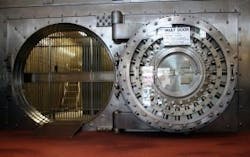Green Banks, Green Bonds: Financing Clean Energy Projects in India
Photo: Wikipedia Commons
India is currently Asia’s third largest clean energy market, and is poised to become the largest in the next decade. It also has some ambitious renewable energy and climate goals: to produce 160 GW of power from solar, wind and other renewable energy by 2022. How much might this cost? Approximately INR 17.5 trillion—some $264 billion—in financing.
Two fast-growing financing tools—green banks and green bonds—could provide a boost to help the country reach its target, according to an analysis from the Indian Renewable Energy Development Agency in partnership with the Natural Resources Defense Council and the Council on Energy, Environment and Water.
Green banks are public entities created to work with the private sector to increase investment in clean energy and bring clean energy financing into the mainstream. A green bank could offer lower interest charges than traditional banks and tap into international capital to finance solar and wind projects to help India power its cities and rural communities. Green banks have been successful in the United Kingdom, Australia, Japan, Malaysia, and several U.S. states.
Just three years ago, green bonds financed about $11 billion projects worldwide. This year the financing could rise to $100 billion. To date, India has used green bonds to finance only about $1 billion in clean energy projects.
“Attractive low-cost finance for clean energy projects is crucial for tapping into India’s vast clean energy potential and for transforming India into a low-carbon economy. In 2015, India was the fourth largest issuer of green bonds in the world, raising debt worth $1.1 billion, ahead of several major economies such as China, Japan, Norway and the UK. Scaling up the market for green bonds could further reduce the cost of capital, stimulate the flow of finance from institutional and retail investors, and expand the base of issuers. India is also ready to be home to a green gank, which could offer solutions to overcome local financing barriers to clean energy,” said Arunabha Ghosh, CEEW’s CEO.
A report by NRDC and CEEW, Greening India’s Financial Market, How Green Bonds Can Drive Clean Energy Deployment, explores how green bonds work and how they are being used to finance projects such as renewable energy deployment or climate adaptation initiatives, and offers strategies to further lower the cost of money raised through debt markets in India and abroad.
Greening India’s Financial Market: Investigating Opportunities for a Green Bank in India sketches how India might establish itself as a country on the forefront of innovation as part of the International Green Bank Network.
***
Microgrid Controller Wins MIT Clean Energy Prize
A microgrid controller created by Heila Technologies, a group of MIT students and alumni, won this year’s MIT Clean Energy Prize. The controller aims to simplify microgrids with a universal control hub that facilitates communication, monitoring and management among various microgrid equipment. The Heila team’s software, Heila IQ, integrates the many ‘languages’ of microgrid systems into a cloud-based platform.
According to MIT News, the team plans to use the $100,000 prize money to implement its microgrid controller technology at military bases and off-grid regions. It has already generated $95,000 in revenue piloting its microgrid controllers at a vineyard in Sonoma County, California.
***
Seeking a Standard for Energy Storage Systems
Chroma Systems Solutions and the Battery Innovation Center (BIC) are partnering to create a microgrid test environment to further development and drive the adoption of the MESA-ESS standard for advanced energy storage systems.
According to the MESA Standard, MESA-ESS specifications address how energy storage systems communicate with the utility’s grid control, while potentially extending these communication specifications to aggregators and facility energy management systems that monitor and control storage assets.
Matt Mills, BIC senior engineer said, “The Chroma 61800 Grid Simulators are at the heart of the Battery Innovation Center’s Microgrid Test Lab. The 61800 series provides the lab’s 480V three phase supply including power monitoring on each phase. Independent phase operation allows charging of one of the lab’s energy storage systems on one leg while discharging on another. With help from Chroma, the Battery Innovation Center is helping to spur the grid energy storage industry adoption of the plug and play MESA standard for Advanced Energy Storage Systems.”
The BIC project is a collaborative initiative designed to incorporate leadership from universities, government agencies, and commercial enterprises to focus on the rapid development, testing and commercialization of safe, reliable and lightweight energy storage systems for defense and commercial customers.
***
A Perfect Campus Microgrid
Operational intelligence company OSIsoft, in partnership with the Illinois Institute of Technology (IIT), made the cut as a top 40 finalist in the 2016 Igniting Innovation Awards, sponsored by The American Council for Technology and Industry Advisory Council (ACT-IAC), for its Perfect Power microgrid.
Intended for—but not limited to—use on college campuses, the Perfect Power microgrid is a self-sustaining electricity infrastructure able to run efficiently and cost-effectively for demand-response through an intelligent distribution system and system controllers.
“Incorporating smart-sensors into microgrids enables users to act autonomously in order to distribute energy efficiently and upon demand,” said Steve Sarnecki, vice president of federal and public sector at OSIsoft. “This type of technology has the potential to make a large impact beyond its original use.”
The Perfect Power microgrid is meant to be a flagship model for universities, municipalities, developments and other facilities looking to establish more self-sustaining, economical operations: Since it produces electricity onsite, facilities no longer have to rely on the operational state of central grids, thus moving further away from dependence on fossil fuels for energy creation.
“With the advantage of being small and somewhat mobile, microgrids offer a unique capability to government and military agencies that require electricity in remote locations and on-the-go situations,” said Mohammad Shahidehpour, chairman in the electrical and computer engineering department at IIT.
Follow us on Twitter @MicrogridNews.







